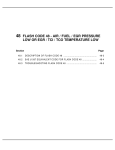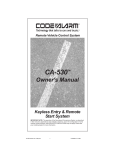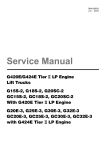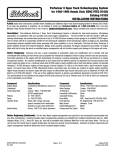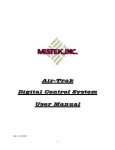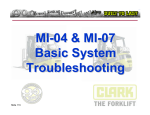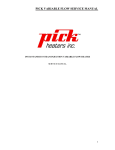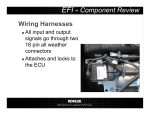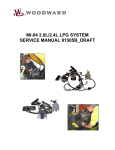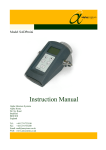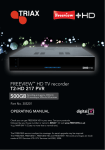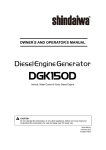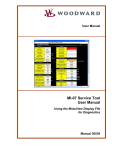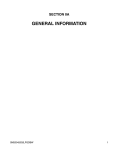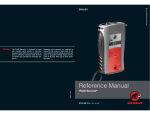Download Tier Dual Fuel System (Gasoline)
Transcript
SB4192E00 Tier Dual Fuel System (Gasoline) G424E/G430E Tier Lift Trucks Dual Fuel Engine G20E-3, G25E-3, G30E-3, G32E-3 with G424E Tier Dual Fuel Engine G20P-3, G25P-3, G30P-3, G32P-3, G33P-3 with G430E Tier Dual Fuel Engine Important Safety Information Most accidents involving product operation, maintenance and repair are caused by failure to observe basic safety rules or precautions. An accident can often be avoided by recognizing potentially hazardous situations before an accident occurs. A person must be alert to potential hazards. This person should also have the necessary training, skills and tools to perform these functions properly. Read and understand all safety precautions and warnings before operating or performing lubrication, maintenance and repair on this product. Basic safety precautions are listed in the “Safety” section of the Service or Technical Manual. Additional safety precautions are listed in the “Safety” section of the owner/operation/maintenance publication. Specific safety warnings for all these publications are provided in the description of operations where hazards exist. WARNING labels have also been put on the product to provide instructions and to identify specific hazards. If these hazard warnings are not heeded, bodily injury or death could occur to you or other persons. Warnings in this publication and on the product labels are identified by the following symbol. WARNING Improper operation, lubrication, maintenance or repair of this product can be dangerous and could result in injury or death. Do not operate or perform any lubrication, maintenance or repair on this product, until you have read and understood the operation, lubrication, maintenance and repair information. Operations that may cause product damage are identified by NOTICE labels on the product and in this publication. DOOSAN cannot anticipate every possible circumstance that might involve a potential hazard. The warnings in this publication and on the product are therefore not all inclusive. If a tool, procedure, work method or operating technique not specifically recommended by DOOSAN is used, you must satisfy yourself that it is safe for you and others. You should also ensure that the product will not be damaged or made unsafe by the operation, lubrication, maintenance or repair procedures you choose. The information, specifications, and illustrations in this publication are on the basis of information available at the time it was written. The specifications, torques, pressures, measurements, adjustments, illustrations, and other items can change at any time. These changes can affect the service given to the product. Obtain the complete and most current information before starting any job. DOOSAN dealers have the most current information available. 1 WARNING Read this entire manual and all other publications pertaining to the work to be performed before installing, operating, or servicing this equipment. Practice all plant and safety instructions and precautions. Failure to follow instructions can cause personal injury and/or property damage. The engine or other type of prime mover should be equipped with an over speed (over temperature, or overpressure, where applicable) shutdown device(s), that operates totally independently of the prime mover control device(s) to protect against runaway or damage to the engine or other type of prime mover with possible personal injury or loss of life should the mechanical-hydraulic governor(s) or electric control(s), the actuator(s), fuel control(s), the driving mechanism(s), the linkage(s), or the controlled device(s) fail. CAUTION To prevent damage to a control system that uses an alternator or battery-charging device, make sure the charging device is turned off before disconnecting the battery from the system. Electronic controls contain static-sensitive parts. Observe the following precautions to prevent damage to these parts. z Discharge body static before handling the control (with power to the control turned off, contact a grounded surface and maintain contact while handling the control). z Avoid all plastic, vinyl, and Styrofoam (except antistatic versions) around printed circuit boards. z Do not touch the components or conductors on a printed circuit board with your hands or with conductive devices. IMPORTANT DEFINITIONS WARNING—indicates a potentially hazardous situation, which, if not avoided, could result in death or serious injury. CAUTION—indicates a potentially hazardous situation, which, if not avoided, could result in damage to equipment. NOTE—provides other helpful information that does not fall under the warning or caution categories. * This manual shows just Dual fuel Engine and engine control system for TIER- Gasoline Engine, so regarding other ares, please refer to the separate manual of SB4136E for G424E TIER- LP Engine and SB4137E for G430E TIER- LP Engine, and SB2215E for G424 Engine(Basic) and SB4005E for G430 Engine(Basic). G424E/G430E Tier Dual Fuel Engine 2 Table of Contents Index CHAPTER 1 ENGINE SPECIFICATION CHAPTER 7 N-CA55-500TR AIR/FUEL MIXER Indication of Engine Serial Number .................... 4 Specifications (G424E Dual Fuel Engine)........... 5 Specifications (G430E Dual Fuel Engine)........... 7 Installing the Mixer/Throttle Assembly - G424E Dual Fuel: ........................................................28 Installing the Mixer/Throttle Assembly - G430E Dual Fuel .........................................................29 CHAPTER 2 DUAL FUEL SYSTEM OPERATIONAL OVERVIEW CHAPTER 8 TEST AND ADJUSTMENTS MI-04 General Description ................................. 9 MI-04 Dual Fuel Gasoline Delivery System ...... 11 MI-04 Gasoline Fuel Injection........................... 13 Testing the Gasoline Fuel Delivery System.......31 Timing Adjustment - G424E LP and Dual Fuel Engine .............................................................34 Ignition Timing Adjustment ...............................34 Timing Adjustment - G430E Dual Fuel Engine ..37 Idle Mixture Adjustment ....................................40 CHAPTER 3 MAINTENANCE SCHEDULE RECOMMENDED MAINTENANCE SCHEDULE14 Replace Gasoline Primary and Secondary Fuel Filter Elements................................................. 14 Inspect the Fuel Pump Insulated Mounting Clamps ........................................................................ 15 Maintenance Schedule..................................... 15 CHAPTER 9 SERVICE TOOL KIT CHAPTER 4 BASIC TROUBLESHOOTING Basic Troubleshooting (Gasoline)..................... 16 CHAPTER 5 MI-04 ADVANCED DIAGNOSTICS Fault List Definitions......................................... 21 Table a. MI-04 Diagnostic Fault Codes (Flash Codes)............................................................. 22 CHAPTER 6 ELECTRICAL CONNECTIONS G424E Dual Fuel Electrical Connection............ 23 G430E Dual Fuel Electrical Connection............ 25 Resistance Checks .......................................... 27 G424E/G430E Tier Dual Fuel Engine 3 Table of Contents CHAPTER 1 ENGINE SPECIFICATION Indication of Engine Serial Number G424E Dual Fuel Engine G430E Dual Fuel Engine G424E/G430E Tier Dual Fuel Engine 4 Engine Specification Specifications (G424E Dual Fuel Engine) GENERAL DESCRIPTION ENGINE TYPE: COMBUSTION SYSTEM: EXHAUST SYSTEM: VALVE CONFIGURATION: DISPLACEMENT: BORE: STROKE: COMPRESSION RATIO: COMPRESSION PRESSURE: VALVE TIMING: FIRING ORDER: SPARK PLUGS: WEIGHT: ROTATION: FUELTYPE: GOVERNED SPEED: IDLE RPM: IGNITIOIN TIMING: Water-cooled, Inline 4-Cycle, 4-Cylinders Naturally Aspirated 1-Venturi Intake Manifold Semi-spherical Combustion chamber Cast Iron, Dry OHC, 2 Valves per Cylinder 2,350 cc (143 CID) 86.5 mm (3.41 in.) 100 mm (3.94 in.) 8.6:1 1,128 kPa (163.5 psi) Intake Valve: 12° BTDC(Open)/ 40° ABDC(Close) Exhaust Valve: 54° BBDC(Open)/ 6° ATDC(Close) 1-3-4-2 BPR5ES: 0.7-0.8 mm (0.028-0.031 in.) Air Gap 146 Kg (322 lbs.), Dry Counter-Clockwise (CCW) when viewed from Flywheel End LPG/Gasoline 2600 +/- 25 RPM 700 +/- 25 RPM for LPG 750 +/- 25 RPM for Gasoline Electronic controlled by ECM LP FUEL SYSTEM MIXER: REGULATOR: FUEL FILTRATION: Piston Type Air Valve Assembly inside, Downdraft Two-Stage Negative Pressure Regulator 40 Microns Maximum GASOLINE FUEL SYSTEM FUEL FILTER-PRIMARY FUEL PUMP FUEL FILTER-SECONDARY GASOLINE REGULATOR ASM FUEL INJECTOR ASS’Y 60 Microns Electric Fuel Pump (12V) 10 Microns Gasoline Pressure Regulator (270kPa) Electric Fuel Injector (12V) COOLING SYSTEM WATER PUMP ROTATION: THERMOSTAT: COOLING WATER CAPACITY: V-Belt Drive - Clockwise (CW) when viewed from engine front Opening Temperature: 82°C (180°F) Fully Open Temperature: 95°C (203°F) 3.1 L (block only) LUBRICATION SYSTEM OIL PRESSURE: OIL TEMPERATURE: CRANKCASE CAPACITY: OIL FILTER: ENGINE OIL SPECIFICATION: 50 kPa (7 psi) @ Low Idle 450 kPa (65 psi) @ Hi Idle Upper Limit: 125°C (257°F) Recommended: 99 - 110°C (210 - 230°F) Lower Limit: 80°C (176°F) 3.7 L 0.3 L API - SJ, SAE 10W30 or SAE 5W30 ENGINE ELECTRICAL IGNITION TYPE: IGNITION COIL: DISTRIBUTOR: STARTER MOTOR: ALTERNATOR: ENGINE OIL PR. S/W: ENGINE CONTROL MODULE(ECM): VR SENSOR: TMAP: PEDAL ANGLE SENSOR: OXYGEN SENSOR: ECT-ECM: ECT-GAUGE TPS: G424E/G430E Tier Dual Fuel Engine Electronic Advanced by ECM 12 V operation volt, Ignition driver circuitry inside Mitsubishi Distributor 12 Volt, 1.2 kW, Reduction drive 12 Volt, 61 Amp 24.5 kPa (3.6 psi) 12 V operation volt, 24 pins of I/O Magnetic pick up sensor(assembled on Timing belt cover) Intake Air Temp. & Manifold Absolute Press. Sensor Two-Output Signals (Installed on Accelerator Pedal) Heated Exhaust Gas Oxygen Sensor (HEGO) 12 V operation volt Engine Coolant Temperature Sensor for ECM Engine Coolant Temp. Sensor for GAUGE on Instrument Panel Throttle Position Sensor (built in Throttle Body) 5 Engine Specification THROTTLE BODY: FUEL TRIM VALVE (FTV): LP FUEL LOCK-OFF: Electronic Throttle Body 12 V operation volt 12 V operation volt, ON/OFF Control by ECM EXHAUST SYSTEM CATALYTIC MUFFLER: G424E/G430E Tier Three-way Catalyst included Dual Fuel Engine 6 Engine Specification Specifications (G430E Dual Fuel Engine) GENERAL DESCRIPTION ENGINE TYPE: COMBUSTION SYSTEM: EXHAUST SYSTEM: VALVE CONFIGURATION: DISPLACEMENT: BORE: STROKE: COMPRESSION RATIO: COMPRESSION PRESSURE: FIRING ORDER: SPARK PLUGS: WEIGHT: Water-cooled, Inline 4-Cycle, 4-Cylinders Naturally Aspirated 1-Venturi Intake Manifold Cast Iron, Dry Pushrod Actuated Overhead Valves - 2 Per Cylinder 2.967 cc (181 CID) 101.60 mm (4.00 in.) 91.44 mm (3.60 in.) 9.25:1 690 kPa (100 psi) Minimum 1-3-4-2 AC R46TS - 0.9 mm (0.035 in.) Air Gap 165 Kg (363 lbs.), Dry Counter-Clockwise (CCW) when viewed from Flywheel End LPG/Gasoline 2500 +/- 25 RPM 700 +/- 25 RPM for LPG, 750 +/- 25 RPM for Gasoline Electronic controlled by ECM ROTATION: FUELTYPE: GOVERNED SPEED: IDLE RPM: IGNITIOIN TIMING: LP FUEL SYSTEM MIXER: REGULATOR: FUEL FILTRATION: GASOLINE FUEL SYSTEM Piston Type Air Valve Assembly inside, Downdraft Two-Stage Negative Pressure Regulator 40 Microns Maximum FUEL FILTER - PRIMARY ELECTRIC FUEL PUMP FUEL FILTER - SECONDARY GASOLINE REGULATOR ASM FUEL INJECTOR ASS’Y 60 Micron Electric Fuel Pump (12V) 10 Micron Gasoline Pressure Regulator (270kPa) Electric Fuel Injector (12V) COOLING SYSTEM V-Belt Drive - Clockwise (CW) when viewed from engine front Opening Temperature: 82°C (180°F) Fully Open Temperature: 96°C (205°F) 3.8 L (block only) WATER PUMP ROTATION: THERMOSTAT: COOLING WATER CAPACITY: LUBRICATION SYSTEM 28 kPa (4 psi) @ 700 RPM 124 kPa (18 psi) @ 2000 RPM Upper Limit: 130°C (266°F) Recommended: 99 - 110°C (210 - 230°F) Lower Limit: 80°C (176°F) 3.8 L (4.0 qts.) 0.95 L (1 qt.) API - SJ, SAE 10W30 OIL PRESSURE (MIN. HOT): OIL TEMPERATURE: CRANKCASE CAPACITY: OIL FILTER: ENGINE OIL SPECIFICATION: ENGINE ELECTRICAL IGNITION TYPE: IGNITION COIL: DISTRIBUTOR: STARTER MOTOR: ALTERNATOR: ENGINE OIL PR. S/W: ENGINE CONTROL MODULE(ECM): Electronic Advanced by ECM 12 V operation volt Delco EST Distributor with ignition module 12 Volt, 2.0 kW 12 Volt, 61 Amp 21.4 kPa (3.1 psi) 12 V operation volt, 24 pins of I/O Magnetic pick up sensor(assembled on Flywheel Housing) Intake Air Temp. & Manifold Absolute Press. Sensor Installed on Accelerator Pedal Heated Exhaust Gas Oxygen Sensor (HEGO) 12 V operation volt Engine Coolant Temperature Sensor for ECM VR SENSOR: TMAP: PEDAL ANGLE SENSOR: OXYGEN SENSOR: ECT-ECM: G424E/G430E Tier Dual Fuel Engine 7 Engine Specification Engine Coolant Temp. Sensor for GAUGE on Instrument Panel Throttle Position Sensor (built in Throttle Body) Electronic Throttle Body 12 V operation volt 12 V operation volt, ON/OFF Control by ECM ECT-GAUGE TPS: THROTTLE BODY: FUEL TRIM VALVE (FTV): LP FUEL LOCK-OFF: EXHAUST SYSTEM CATALYTIC MUFFLER: G424E/G430E Tier Dual Fuel Engine Three-way Catalyst included 8 Engine Specification CHAPTER 2 DUAL FUEL SYSTEM OPERATIONAL OVERVIEW MI-04 General Description Woodward’s MI-04 control system is designed to provide a complete, fully integrated solution that will meet or exceed TIER-2 Large Spark Ignited Engines emission standards established by the California Air Research Board (CARB) and the Environmental Protection Agency (EPA) for 2004. The MI-04 is a closed loop system utilizing a catalytic muffler to reduce the emission level in the exhaust gas. In order to obtain maximum effect from the catalyst, an accurate control of the air fuel ratio is required. A small engine control module (SECM) uses a heated exhaust gas oxygen sensor (HEGO) in the exhaust system to monitor exhaust gas content. MI-04 Dual Fuel System of G424E Engine LP Fuel Line Fault Light Key switch Foot Pedal APP Main PWR Relay LP Fuel Filter Fuel Lock Fuel Select Switch Converter Vacuum Air Cleaner Coolant Line Fuel Trim Valve 2 Fuel Select Relay 1&2 Mixer Fuel Pump Fuel Injector DBW Throttle TPS TMAP Engine 1 SECM Oxygen Sensor Distributor Smart Coil VR Sensor Oil Pressure Switch Coolant Temp Sensor Catalytic Muffler Figure 10 G424E/G430E Tier Dual Fuel Engine 9 System Operational Overview The SECM makes any necessary corrections to the air fuel ratio by controlling the inlet fuel pressure to the air/fuel mixer by modulating the fuel trim valve (FTV) connected to the regulator. Reducing the fuel pressure leans the air/fuel mixture and increasing the fuel pressure enriches the air/fuel mixture. To calculate any necessary corrections to the air fuel ratio, the SECM uses a number of different sensors to gain information about the engines performance. Engine speed is monitored by the SECM through a variable reluctance (VR) sensor. Intake manifold air temperature and absolute pressure is monitored with a (TMAP) sensor. The MI-04 is a drive by wire (DBW) system connecting the accelerator pedal to the electronic throttle through the electrical harness; mechanical cables are not used. A throttle position sensor (TPS) monitors throttle position in relation to the accelerator pedal position sensor (APP) feedback. Even engine coolant temperature and adequate oil pressure is monitored by the SECM. The SECM controller has full adaptive learning capabilities, allowing it to adapt control function as operating conditions change. Factors such as ambient temperature, fuel variations, ignition component wear, clogged air filter, and other operating variables are compensated. MI-04 Dual Fuel System of G430E Engine Fault Light LP Fuel Line Key switch Foot Pedal APP LP Fuel Filter Main PWR Relay Fuel Lock Fuel Select Converter Vacuum Air Cleaner Coolant Line Fuel Trim Valve 2 Mixer Fuel Pump Fuel Select Relay 1&2 Fuel Injector DBW Throttle TPS TMAP 1 SECM Oxygen Sensor Distributor VR Sensor Oil Pressure Switch Coolant Temp Sensor Engine Catalytic Muffler Figure 10 G424E/G430E Tier Dual Fuel Engine 10 System Operational Overview The pump discharge is located on the electrical terminal side of the pump. Both fuel filters and fuel pump have a specific inlet orientation to fuel flow, which should be noted upon installation. MI-04 Dual Fuel Gasoline Delivery System A manual fuel select switch enables the forklift operator to choose between LPG or Gasoline operation. When the select switch is in the Gasoline position an electric fuel pump supplies the fuel and generates the injection pressure. The fuel is pumped through a Primary 60 micron filter to the pump (Figure 23). The pump then discharges the fuel at an increased pressure through a Secondary 10 micron filter to a pressure regulator. The pressure regulator incorporates a spring-loaded diaphragm with no bias signal connected, maintaining a constant operating fuel pressure at the metering orifice (270 Kpa) regardless of the amount of fuel being injected. The electric fuel pump incorporates a G-Rotor pumping element driven by an electric motor with permanent magnets, an internal check valve to prevent back flow and is mounted external from the fuel tank. Secondary Fuel Filter Figure 24 Fuel Select Switch Secondary Gasoline Filter Flow Electric Fuel Pump Primary Gasoline Filter Electric Fuel Pump *Mounting locations shown are specific to G20/25/30E-3 model. G424E/G430E Tier Dual Fuel Engine 11 System Operational Overview The fuel pressure regulator returns fuel to the tank through the return line when the fuel pressure is too great. (Figure 25) (Figure 26) shows the fuel pressure regulator mounted near the battery tray. Tank Return Line Fuel Outlet Fuel Inlet Figure 25 A single fuel injector is controlled by the SECM and when energized meters fuel before the throttle into the mixer to throttle adapter. For proper fuel atomization and delivery to the throttle, a separate venturi booster section has been installed inside the mixer to throttle adapter. Figure 26 WARNING The gasoline fuel injection system of the MI-04 system operates at a fuel pressure of 270 Kpa (~39psi). Pressurized fuel is present in the fuel lines when the engine is not running. Safety glasses should be worn at all times when removing fuel lines or eye injury may occur! Avoid directing high-pressure fuel spray onto hot engine components!. G424E/G430E Tier Dual Fuel Engine 12 System Operational Overview MI-04 Gasoline Fuel Injection In (Figure 29) the fuel injector is shown out of the throttle body adapter. A spacer is used on the tip of the injector to properly seat the injector with the venturi o-ring. A single Seimens high flow fuel injector is used to inject fuel into the LPG mixer to throttle adapter. Intake air to the engine continues to flow through the LPG mixer however propane is not supplied to the mixer while in gasoline operation. A booster venturi (Figure 27) inside the adapter receives the fuel from the injector and distributes it into the air stream before the throttle valve. The VR signal from the 30-5 timing wheel located on the crankshaft pulley is used by the SECM as an engine position reference for correct operation of the injector. The SECM uses the measured air-fuel ratio from the oxygen sensor to control the amount of fuel delivered by the injector. Figure 29 Figure 27 A view of a separate injector venturi used in a twopiece throttle adapter is shown in (Figure 28) for a clearer description. The MI-04 dual fuel throttle adapter uses a single piece adapter where the venturi cannot be removed. Figure 28 G424E/G430E Tier Dual Fuel Engine 13 System Operational Overview CHAPTER 3 MAINTENANCE SCHEDULE RECOMMENDED MAINTENANCE SCHEDULE Replace Gasoline Primary and Secondary Fuel Filter Elements Suggested maintenance requirements for an engine equipped with an MI-04 fuel system are contained in this section. The owner should, however, develop his own maintenance schedule using the requirements listed in this section and any other requirements listed by the engine manufacturer.. Secondary Gasoline Filter Flow Electric Fuel Pump Primary Gasoline Filter Park the lift truck in an authorized refueling area with the forks lowered, parking brake applied and the transmission in Neutral. 1. Place the fuel select switch in the Gasoline position. Remove the fuel select relay #2 for the electric fuel pump. Start and run the engine until the fuel in the system runs out of fuel and the engine stops. 2. Turn off the ignition switch. 3. Replace the fuel filter taking care to install the new filter with flow in the proper direction. When replacing the Primary fuel filter use a hose clamp between the tank and the filter to prevent fuel from spilling during replacement. 4. Prefilling the primary gasoline filter with fuel will greatly reduce the cranking time necessary to prime the pump anytime the primary gasoline filter or pump is drained for service. 5. Re-install the fuse for the pump and crank the engine several times before attempting a start to prime the fuel pump. G424E/G430E Tier Dual Fuel Engine 14 System Operational Overview Inspect the Fuel Pump Insulated Mounting Clamps • • • • • Turn the ignition key to the ON position (without cranking the engine), you should hear the electric fuel pump running. After 5 seconds the pump should stop running. If the pump continues to run check the rubber insulation on the electric fuel pump mounting clamps. If the housing of the pump makes contact with the engine chassis a ground path can be created causing the pump to run anytime the ignition key is in the ON position and the fuel select switch is in GAS position, causing pre-mature pump failure. If the clamp insulation is damaged replace the clamp with a new insulated clamp. Maintenance Schedule Interval Hours CHECK POINT Daily Every 250hrs or a month Every 500 Hours or 3 months Every 1000 Hours or 6 months Every 1500 Hours or 9 months Every 2500 Hours or 15 months Every 4000 Hours or 2 years Fuel Lock-Off/Fuel Filter Section (LPG & Gasoline) Replace Primary Gasoline fuel filter Replace Secondary Gasoline fuel filter Inspect fuel pump insulated retaining clamps G424E/G430E Tier Dual Fuel Engine X X X 15 System Operational Overview CHAPTER 4 BASIC TROUBLESHOOTING Basic Troubleshooting (Gasoline) The MI-04 systems are equipped with built-in fault diagnostics. Detected system faults can be displayed by the Malfunction Indicator Lamp (MIL) and are covered in the Advanced Diagnostics section. Items such as fuel level, plugged fuel lines, clogged fuel filters and malfunctioning pressure regulators may not set a fault code by the Small Engine Control Module (SECM). Below are basic checks that should be made before referring to the Advanced Diagnostics section, if engine or drivability problems are encountered. Consider all parts of the ignition and mechanical systems as well as the fuel system. Problem Probable Cause Engine Cranking but Will Not Start (Gas) G424E/G430E Tier Corrective Action Fuel tank empty Fill fuel container z The tank should be at least ¼ full to properly prime the fuel pump. z Fuel select switch is not on GAS Clogged fuel filter Repair/replace as required z See Primary and Secondary Fuel Filter replacement Improper fuel supply line connection between the tank and the fuel pump Check connection z Verify correct hose connections z Clamps must be tight z Look for kinked, pinched and/or collapsed hose Electric Fuel Pump malfunction (GAS) Check electrical connection z Check Relay and fuse Turn key ON and verify pump is operating Fuel Pressure regulator malfunction Test pressure regulator operation z See Tests and Adjustments Fuel Injector malfunction Test Injector operation z See Tests and Adjustments Incorrect air/fuel or ignition/spark control See Advanced Diagnostics No VR Sensor Signal Verify the VR signal is present z See Advanced Diagnostics Dual Fuel Engine 16 Basic Troubleshooting Problem Difficult to Start (Gas) Will Not Run Continuously (Gas) Probable Cause Corrective Action Fuel tank almost empty Fuel Pump Cavitations z The tank should be at least ¼ full to properly prime the fuel pump z Fuel select switch is not on GAS Clogged fuel filter Repair/replace as required z See Primary and Secondary Fuel Filter replacement Electric Fuel Pump malfunction (GAS) Check electrical connection z Check Relay and fuse Turn key ON and verify pump is operating z See Tests and Adjustments Pressure regulator malfunction Test pressure regulator operation z See Tests and Adjustments Fuel Injector malfunction Test Injector operation z See Tests and Adjustments Air filter clogged Check air filter z Clean/replace as required Incorrect air/fuel or ignition control See Advanced Diagnostics Engine Mechanical See Engine Manufacturers Service Manual Isolate the gasoline system by running the lift truck on LPG Verify LPG cylinder is full and valve is open. If the problem does not exist in LPG mode proceed with the corrective action steps below. If the problem also exists in LPG mode then the root cause is most likely to be something other than the fuel system z See Advanced Diagnostics G424E/G430E Tier Fuel tank almost empty Fuel Pump Cavitations z The tank should be at least ¼ full to properly prime the fuel pump Clogged fuel filter Repair/replace as required z See Primary and Secondary Fuel Filter replacement Dual Fuel Engine 17 Basic Troubleshooting Problem Probable Cause Will Not Run Continuously (Gas) Will Not Accelerate/Hesitation During Acceleration or Engine Stalls (Gas) Corrective Action Electric Fuel Pump malfunction (GAS) Check electrical connection z Check Relay and fuse Turn key ON and verify pump is operating z See Tests and Adjustments Pressure regulator malfunction Test pressure regulator operation z See Tests and Adjustments Fuel Injector malfunction Test Injector operation z See Tests and Adjustments Incorrect idle speed or ignition problem See Advanced Diagnostics Engine Mechanical See Engine Manufacturers Service Manual Isolate the gasoline system by running the lift truck on LPG Verify LPG cylinder is full and valve is open. If the problem does not exist in LPG mode proceed with the corrective action steps below. If the problem also exists in LPG mode then the root cause is most likely to be something other than the fuel system z See Advanced Diagnostics G424E/G430E Tier Fuel tank almost empty Fuel Pump Cavitations z The tank should be at least ¼ full to properly prime the fuel pump Clogged fuel filter Repair/replace as required z See Primary and Secondary Fuel Filter replacement Pressure regulator malfunction Test pressure regulator operation z See Tests and Adjustments Fuel Injector malfunction Test Injector operation z See Tests and Adjustments Dual Fuel Engine 18 Basic Troubleshooting Problem Probable Cause Will Not Accelerate/Hesitation During Acceleration or Engine Stalls (Gas) Throttle butterfly valve not opening or sticking Corrective Action See Advanced Diagnostics Foot Pedal signal incorrect or intermittent Incorrect air/fuel or ignition control Rough Idle (Gas) Engine Mechanical See Engine Manufacturers Service Manual Isolate the gasoline system by running the lift truck on LPG Verify LPG cylinder is full and valve is open. If the problem does not exist in LPG mode proceed with the corrective action steps below. If the problem also exists in LPG mode then the root cause is most likely to be something other than the fuel system z See Advanced Diagnostics & Tests and Adjustments G424E/G430E Tier Pressure regulator malfunction Test pressure regulator operation z See Tests and Adjustments Clogged fuel filter Repair/replace as required z See Primary and Secondary Fuel Filter replacement Pressure regulator malfunction Test pressure regulator operation z See Tests and Adjustments Fuel Injector malfunction Test Injector operation z See Tests and Adjustments Vacuum leak Check for vacuum leaks z Between mixer and throttle body z Between throttle body and intake manifold z Between intake manifold and cylinder head Dual Fuel Engine 19 Basic Troubleshooting Problem Probable Cause Rough Idle (Gas) Incorrect Idle speed control Incorrect timing or spark control High Idle Speed (Gas) Corrective Action See Advanced Diagnostics & Tests and Adjustments Engine Mechanical See Engine Manufacturers Service Manual Incorrect Idle speed control See Advanced Diagnostics & Tests and Adjustments Throttle sticking Poor High Speed Performance (Gas) Foot pedal sticking or incorrect pedal signal Check pedal return spring travel for binding See Advanced Diagnostics Isolate the gasoline system by running the lift truck on LPG Verify LPG cylinder is full and valve is open. If the problem does not exist in LPG mode proceed with the corrective action steps below. If the problem also exists in LPG mode then the root cause is most likely to be something other than the fuel system z See Advanced Diagnostics & Tests and Adjustments Poor High Speed Performance (Gas) Clogged fuel filter Repair/replace as required z See Fuel Filter replacement Plugged fuel line Remove obstruction from the fuel line z Close liquid fuel valve z Using caution, disconnect the fuel line (some propane may escape) z Clear obstruction with compressed air z Re-connect fuel line z Slowly open liquid fuel valve & Leak test Air filter clogged Check air filter z Clean/replace as required Faulty vapor connection between the pressure regulator/converter and the mixer Check connection z Verify no holes in hose z Clamps must be tight z Look for kinked, pinched and/or collapsed hose Pressure regulator malfunction Test pressure regulator operation z See Tests and Adjustments Air/Fuel Mixer malfunction Check mixer z See Air/Fuel mixer section Restricted exhaust system Check exhaust system z Measure exhaust back pressure Incorrect ignition control See Advanced Diagnostics & Tests and Adjustments Incorrect air/fuel control Incorrect throttle position G424E/G430E Tier Dual Fuel Engine 20 Basic Troubleshooting CHAPTER 5 MI-04 ADVANCED DIAGNOSTICS Fault List Definitions Several sensors in the MI-04 system have input low/high faults and a sensor range fault. These are the coolant temperature sensor, the throttle position sensor and the pedal position sensors. Signals to these sensors are converted into digital counts by the SECM. A low/high sensor fault is normal set when the converted digital counts reach the minimum of 0 or the maximum of 1024 (1024=5.0 VDC with ~204 counts per volt). A sensor range fault is set if the parameter measured by the sensor is outside the normal operating range. 1024 Counts (Input High) Sensor Range 0 Counts (Input Low) Figure F1 Injector Fault: (Fuel Injector Fault) is normally set when the injector driver signal is open due to the connector becoming disconnected. Low Oil Pressure: (Low Oil Pressure) the oil pressure switch has closed or become failed, normally indicating a low oil condition in the engine. G424E/G430E Tier Dual Fuel Engine 21 Advanced Diagnostics Table a. MI-04 Diagnostic Fault Codes (Flash Codes) DFC 51 Probable Fault Injector Fault Action Stored Fault Code (MIL, Disable Adaptive learns) Corrective Action, First Check Check Injector (INJ) for an open wire or injector connector being disconnected INJ PIN A (SIGNAL) TO PIN B (PWR) Check INJ for an open coil by disconnecting the INJ connector and measuring the coil resistance (~12Ω +/2Ω) INJ PIN A (SIGNAL) TO PIN B (PWR) 52 Low Oil Pressure Low Engine Oil Pressure Delayed Engine Shutdown Check engine oil level Check electrical connection to the oil pressure switch SECM PIN 23 to Oil Pressure Switch 31 Running Reset Stored Fault Code Reset Counter to be incremented Check to ensure that proper grounding of the harnessing has been achieved. Check to ensure that there are no intermittent connections in the electrical harness or associated connections. Check for interruptions in Vbatt supply to the SECM. Check to ensure that the ignition system (distributor, coil, cap, rotor, plugs, and high tension leads) is operating normally. G424E/G430E Tier Dual Fuel Engine 22 Advanced Diagnostics CHAPTER 6 ELECTRICAL CONNECTIONS G424E Dual Fuel Electrical Connection Ignition Switch Main PWR Relay Battery SECM Fuel Select Switch Fuel Select Relay 2 Fuel Injector MIL Fuel Select Relay 1 Electronic Throttle Fuel Pump Fuel Lock-Off TMAP Sensor Fuel Trim Valve Smart Coil VR Sensor ECT Sensor DBW Foot Pedal Oil Pressure Switch Oxygen Sensor Figure E1 G424E/G430E Tier Dual Fuel Engine 23 Electrical Connections Figure E2 G424E/G430E Tier Dual Fuel Engine 24 Electrical Connections G430E Dual Fuel Electrical Connection Ignition Switch Main PWR Relay Battery Fuel Select Switch SECM Fuel Injector Fuel Select Relay 2 MIL Fuel Select Relay 1 Electronic Throttle Fuel Pump Fuel Lock-Off TMAP Sensor Distributor Fuel Trim Valve VR Sensor ECT Sensor Oxygen Sensor DBW Foot Pedal Oil Pressure Switch Figure E1 G424E/G430E Tier Dual Fuel Engine 25 Electrical Connections Figure E2 G424E/G430E Tier Dual Fuel Engine 26 Electrical Connections Resistance Checks NOTE All resistive checks are made with the sensor or device disconnected from the harness. CONNECTOR INJ (FUEL INJECTOR) POINT TO POINT INJ PIN A (SIGNAL) TO PIN B (PWR) CONNECTOR FUEL PUMP (GAS) POINT TO POINT PUMP HOUSING TO CHASSIS CONNECTOR VR SENSOR G424E/G430E Tier POINT TO POINT VR PIN 1 (+) TO PIN 2 (-) Dual Fuel Engine 27 EXPECTED RANGE (~12Ω +/-2Ω) EXPECTED RANGE (0Ω)*Pump housing should be isolated from chassis ground EXPECTED RANGE ~320Ω Electrical Connections CHAPTER 7 N-CA55-500TR AIR/FUEL MIXER Installing the Mixer/Throttle Assembly - G424E Dual Fuel: 1 2 3 4 5 6 7 8 9 10 11 12 13 13A 13B 13C 13D 13E 14 15 17 18 19 20 21 22 23 24 25 26 27 28 29 30 31 32 GASKET-INTAKE MANIFOLD ADAPTER-INTAKE MANIFOLD BRACKET-TMAP BOLT-TMAP BRACKET TMAP SENSOR WASHER-TMAP MTG BOLT-TMAP MTG BOLT-ADAPTER GASKET-ITB THROTTLE BODY(ITB 32MM) O-RING O-RING SPACER LP MIXER(CA55) FITTING-ORIFICE GASKET-MIXER,AIR HORN GASKET-MIXER,ADAPTER SCREW CAP-IDLE SCREW FITTING-FUEL G424E/G430E Tier Dual Fuel Engine 28 INJECTOR ASSEMBLY FUEL HOSE VENTURI VENTURI SPACER APOLLO ADAPTER BOLT-INJECTOR MTG WASHER-SPRING SET SCREW O-RING FITTING BOLT-END PLUG WASHER BOLT AIR HORN ADAPTER WASHER BOLT FITTING-VENTILATION COOLANT TEMP SENSOR-ECM N-CA55-500TR Mixer Installing the Mixer/Throttle Assembly - G430E Dual Fuel 1 2 3 4 5 6 7 8 9 10 11 12 13 14 15 15A 15B 15C 15D 15E 16 17 17A 18 19 20 21 22 23 24 25 26 27 28 29 30 31 32 33 34 GASKET-INTAKE MANIFOLD ADAPTER-INTAKEMANIFOLD BRACKET-TMAP BOLT-TMAP BRACKET FITTING-OUTLET FITTING-INLET TMAP WASHER-TMAP MTG BOLT-TMAP MTG BOLT-ADAPTER GASKET-ITB THROTTLE BODY O-RING O-RING SPACER MIXER FITTING-ORIFICE GASKET-MIXER,AIR HORN GASKET-MIXER,ADAPTER SCREW CAP-IDLE SCREW FITTING-TO CONVERTER INLET G424E/G430E Tier Dual Fuel Engine 29 INJECTOR ASSEMBLY FUEL HOSE VENTURI VENTURI SPACER APOLLO ADAPTER FOR DUAL FUEL BOLT-INJECTOR MTG WASHER SET SCREW O-RING FITTING-TO TRIM V/V BOLT-END PLUG BOLT-ITB.CONN AIR-HORN ADAPTER WASHER-AIR HORN BOLT-AIR HORN PLUG HOSE-COOLANT(FORMED) CLAMP-HOSE(WATER PUMP) CLAMP-HOSE(FITTING) N-CA55-500TR Mixer CHAPTER 8 TEST AND ADJUSTMENTS WARNING z z z LP gas is highly flammable. To prevent personal injury, keep fire and flammable materials away from the lift truck when work is done on the fuel system. Gas vapor may reduce oxygen available for breathing, cause headache, nausea, dizziness and unconsciousness and lead to injury or death. Always operate the forklift in a well ventilated area Liquid propane may cause freezing of tissue or frostbite. Avoid direct contact with skin or tissue; always wear appropriate safety protection including gloves and safety glasses when working with liquid propane. CAUTION The regulator/converter and mixer are part of a certified system complying with EPA and CARB 2004 requirements. Only trained certified technicians should perform disassemble, service or replacement of the regulator/converter or mixer. G424E/G430E Tier Dual Fuel Engine 30 TEST AND ADJUSTMENTS Testing the Gasoline Fuel Delivery System Gasoline System Test Hardware 1. Universal 278000 Noid “test” light 2. Pinch-off pliers, hose clamp or Vise-Grip type pliers 3. Small fuel “catch” container. Operating fuel pressure of the gasoline system is 270 Kpa (~39 psi). At least ¼ of the fuel tank should be filled with fuel to provide a proper fuel prime from the tank “pick-up” tube to the fuel pump, anything less may cause the pump to cavitate allowing air into the fuel system. A primary 100-micron fuel filter is used inline before the electric fuel pump and a 10-micron secondary fuel filter is used between the fuel pump and the fuel pressure regulator. The regulator does not use a bias control signal on the diaphragm and always supplies a constant pressure. When fuel pressure is too high the regulator routes excessive fuel through the return line back to the fuel tank. Regulated fuel pressure is supplied from the regulator outlet exits to the fuel injector. The fuel lines from the fuel pump to the injector are under pressure even when the engine is not running and care should be taken when disconnecting these fuel lines, as pressurized fuel will be discharged. Fuel Tank Outlet st 1 Filter to Pump nd Pump to 2 Filter Regulator Inlet Return to Tank Fuel Tank Outlet Figure F1 NOTE Pump, filter and regulator mounting locations as shown are specific to G20/25/30E-3 lift trucks G424E/G430E Tier Dual Fuel Engine 31 TEST AND ADJUSTMENTS The return line from the regulator to the fuel tank is not under pressure and can safely be removed without pressurized fuel spray. To check for SECM signal pulses to the fuel injector simply disconnect the electrical harness from the fuel injector and connect the Noid test light to the end of the harness in place of the injector. Crank the engine with the ignition key and you will see the Noid light flash every time the SECM sends a signal to the fuel injector to open and spray fuel. If SECM pulses are not present at the injector and a DFC code 51 (Injector Fault) has not been set, the Fuel Select Relay #1 may be at fault. Verify that the Fuel Selector Switch is in the Gasoline position before performing the following tests. A fuel pressure tap is not provided in the MI04 gasoline system. In order to check the operating fuel pressure of the system a pressure gauge and T fitting must be installed before the pressure regulator to measure fuel pump supplied pressure or after the pressure regulator to measure regulated pressure. When the Fuel Select Switch is placed in the Gas position a low or ground signal is supplied through the switch to PIN 8 of the SECM. This ground signal informs the SECM that the lift truck should operate in Gasoline mode. When the SECM PIN 8 input is “low”, the SECM PIN 21 output becomes “low” supplying the ground signal to the coil of both the #1 and #2 Fuel Select Relays. Voltage (+12 VDC) is supplied to one side of the coil for both the #1 and #2 Fuel Select Relays when the key switch is in the ON position. When the #1 Fuel Select Relay coil is energized the relay will switch SECM PIN 12 output from the FTV to the fuel injector. The SECM PIN 12 output signal supplies the fuel injector with the correct drive pulses. WARNING The gasoline fuel injection system of the MI-04 system operates at a fuel pressure of 270 Kpa (~39psi). Pressurized fuel is present in the fuel lines when the engine is not running. Safety glasses should be worn at all times when removing fuel lines or eye injury may occur! Avoid directing high-pressure fuel spray onto hot engine components! As a “quick check” of fuel system performance, the tank return line from the regulator can be removed from the tank fitting and placed into a small empty fuel container or “fuel catch”. If the fuel pump is supplying sufficient fuel pressure and the regulator is functioning properly, the regulator will bypass fuel through the return line while the engine is running. If no fuel is bypassed through the return line while the engine is running, insufficient fuel pressure may be the cause either from a faulty fuel pump or clogged fuel filter. NOTE Refer to Electrical Connections for the system wiring schematic of the Fuel Select Relays. If the fuel pump and regulator are supplying sufficient fuel pressure to the fuel injector, the fuel injector may be faulty and can be checked with a universal Noid test light. (FIGURE F2) Figure F2 Universal 278000 Noid Test Light G424E/G430E Tier Dual Fuel Engine 32 TEST AND ADJUSTMENTS If the Noid light shows valid signals from the SECM to the injector, a final visual check of the fuel injector can be made. To check the actual fuel discharge from the fuel injector, remove the fuel injector mounting-bolt from the mixer to throttle adapter and remove the fuel injector. Place the fuel injector in an appropriate fuel container so that any fuel spray from the injector will remain in the container during the test. You can simply crank the engine and visually watch the fuel injector open or if available you may use the injector test in the Service Tool software. Figure G3 Figure G4 NOTE Take care not to lose the injector spacer when removing the fuel injector. (FIGURE G3). To use the injector test in the Service Tool software simply select the checkbox to the right of the INJECTOR TEST. (FIGURE G4) The box will change to read Enabled and the test mode will go active. This will pulse the injector for 7 seconds when the engine is not running. CAUTION Running the injector test with the injector installed in the throttle adapter will discharge raw gasoline into the intake manifold and could result in excessive engine wear through misfire or loss of lubrication. G424E/G430E Tier Dual Fuel Engine 33 TEST AND ADJUSTMENTS Timing Adjustment - G424E LP and Dual Fuel Engine 1. Using the timing indicator on the crankshaft pulley, set the engine on 0 degrees Top Dead Center (TDC) of number 1 cylinder (Figure G1). Ignition Timing Adjustment Distributor with Rotor Cap Removed With the MI-04 system both mechanical and vacuum advance are no longer inside the distributor. All ignition timing advance is controlled by the SECM. The only timing adjustment that can be made by a technician is the mechanical alignment of the distributor. The SECM uses a 40-degree timing window from –5 degrees BTDC to 35 degrees BTDC. Because of this an accurate adjustment cannot be made with a standard timing light since the SECM will maintain the correct timing even if the distributor is moved (as long as the distributor setting remains within the 40-degree window). Therefore the ignition timing setting of the distributor becomes very important and is described in the following steps. Firing Order 1-3-4-2 Timing Wheel at 0 degrees TDC Figure G2 2. Remove the distributor rotor cap and verify that the distributor rotor is lined up with number 1 cylinder on the distributor cap (Figure G2). Distributor View of Internal VR Sensor View of Distributor Rotor Cap Internal VR Sensor #1 Cylinder Signal Rotor 3. Remove the distributor rotor and dust cover so that the internal VR sensor and signal rotor gear are visible (Figure G3). The internal VR sensor inside the distributor is not used by the SECM for a speed reference with the G420E/G424E engine and it’s wiring harness does not connect to the system. The distributors internal VR sensor is only used as an alignment reference point for setting the correct distributor position. Figure G1 G424E/G430E Tier Dual Fuel Engine 34 TEST AND ADJUSTMENTS Incorrect Alignments #1 Tooth Flat Side of Shaft Figure G4 4. Loosen the distributor hold down nut and rotate the distributor so that the signal rotor gear tooth of the #1 cylinder (tooth opposite the flat side of the distributor shaft) lines up with the sensor pickup. (Figure G4). Correct Alignment 1 Figure G5 5. To correctly set the distributor, align the center of the #1 cylinder tooth with the leading edge of the VR sensor pickup (Figure G5). Keep in mind that the distributor rotates in a clockwise direction. 6. Once the proper alignment is obtained, lock the distributor in place by tightening the hold down nut to the specified torque value and re-install the rotor, dust cover and rotor cap. WARNING Improper alignment of the distributor may cause system ignition problems resulting in ignition misfires or backfires. G424E/G430E Tier Dual Fuel Engine 35 TEST AND ADJUSTMENTS Figure G6 Figure G8 7. After you have completed setting the distributor alignment you will need to adjust the VR sensor used by the SECM for speed reference. This sensor is mounted near the crankshaft pulley wheel (Figure G6). 9. Using a feeler gauge (Figure G8), loosen the sensor retaining bolts and adjust the gap between the sensor and the gear tooth from 1.25mm to 1.5mm. Re-tighten the sensor retaining bolts when complete. 10. Rotate the crankshaft pulley 180 degrees and align a timing gear tooth in the center of the VR sensor pickup as you did in step 8. Verify that the sensor gap is still within 1.25mm to 1.5mm. This step is to check timing gear run out and insures proper speed signal amplitude. 11. If the VR sensor gap is not within the specification repeat steps 9 & 10 and continue adjusting the sensor gap until you are within tolerance. This completes setting ignition timing and sets the center of the SECM ignition control range at 15 degrees BTDC. Figure G7 8. Rotate the crankshaft pulley so that one of the gear teeth on the timing wheel aligns in the center of the VR sensor (Figure G7). G424E/G430E Tier Dual Fuel Engine 36 TEST AND ADJUSTMENTS Timing Adjustment - G430E Dual Fuel Engine With the MI-04 system both mechanical and vacuum advance are no longer inside the distributor. All ignition timing advance is controlled by the SECM. The only timing adjustment that can be made by a technician is the mechanical alignment of the distributor. The SECM uses a 40-degree timing window from –5 degrees BTDC to 35 degrees BTDC. Because of this an accurate adjustment cannot be made with a standard timing light since the SECM will maintain the correct timing even if the distributor is moved (as long as the distributor setting remains within the 40-degree window). Therefore the ignition timing setting of the distributor becomes very important and is described in the following steps. Figure G2 Proper Distributor Alignment Rotor Alignment Arrow Figure G1 Module Housing Arrow 1. Using the timing indicator on the crankshaft pulley, set the engine on 0 degrees Top Dead Center (TDC) of number 1 cylinder (Figure G1). Figure G3 2. Remove the distributor rotor cap and verify that the distributor rotor is lined up with number 1 cylinder on the distributor cap (Figure G2). 3. The internal distributor alignment arrows are now visible (Figure G3). The internal crank signal from the GM ignition module is not used by the SECM for a speed reference with the 3.0L engine. The distributors internal alignment arrows are only used as an alignment reference point for setting the correct distributor position within the timing window. 4. Loosen the distributor hold down bolt and rotate the distributor so that the module-housing arrow aligns with the rotor arrow as shown in Figure G3. G424E/G430E Tier Dual Fuel Engine 37 TEST AND ADJUSTMENTS 5. Once the alignment arrows are adjusted as shown in Figure G3, the outside corner of the distributor housing should not align with the distributor reference mark on the engine block and should resemble the alignment as shown in (Figure G4). 7. After you have completed setting the distributor alignment you will need to adjust the VR sensor used by the SECM for speed reference. This sensor is mounted in the bell housing of the flywheel at the bottom of the engine. Circular timing reference marks have been precisely machined into the surface of the flywheel (Figure G6). The MI-04 VR sensor will use these machined marks for speed reference 6. Once the proper alignment is obtained, lock the distributor in place by tightening the hold down nut to the specified torque value and re-install the distributor rotor cap. VR Sensor Timing Reference Marks Figure G6 Figure G4 WARNING Improper alignment of the distributor may cause system ignition problems resulting in ignition misfires or backfires. Machined Timing Mark VR Sensor Figure G7 8. Figure G7 shows a functional diaghram of the VR sensor and the principle of operation. The sensor will detect each timing mark in the flywheel and output a signal. The larger the gap between the sensor and the flywheel the smaller the amplitude of the speed signal. If the gap is too small the VR sensor will make contact with the flywheel and become damaged during operation. Therefore it is necessary to adjust the VR sensor for proper operation. G424E/G430E Tier Dual Fuel Engine 38 TEST AND ADJUSTMENTS 9. With the engine timing still at 0 degrees TDC, the VR sensor will align between the machined timing marks on the flywheel (Figure G8). Loosen the VR sensor locknut and adjust the sensor inward toward the flywheel until the sensor makes contact with the flywheel. Flywheel surface between the timing marks Figure G8 10. Once the VR sensor makes contact with the flywheel back the sensor outwards 1 turn and tighten down the sensor locknut. This should adjust the sensor signal strength within the proper range. This completes setting ignition timing and sets the center of the SECM ignition control range. WARNING Improper assemble of VR sensor may cause VR sensor failure. . G424E/G430E Tier Dual Fuel Engine 39 TEST AND ADJUSTMENTS Idle Mixture Adjustment 3. Connect a timing light to the engine. 4. Turn the ignition key to the ON position (Do Not Start the Engine). Figure G7 The method for making the idle mixture adjustment to a running engine is to use the Service Tool software by connecting a laptop computer to the SECM. If you do not have the Service Tool a multimeter capable of measuring Duty Cycle, such as a Fluke 87 III, can be used. Connect the meter positive lead to between battery positive and the meter negative to the FTV signal wire. Set the range for 4 or 40 and the MIN/MAX setting to + (usually the default setting of the meter). The multimeter will then read the Duty Cycle percentage the same as the Service Tool. In order to use the Service Tool a USB (Universal Serial Bus) to CAN (Controller Area Network) communication adapter by Kavaser will be required along with a Crypt Token (Figure G7). The Crypt Token acts as a security key allowing the laptop to retrieve the necessary data from the SECM. 5. Launch the MotoView program on your computer and open the Service Tool display. 6. Start the engine; you should now see the idle RPM on your Service Tool display Run Screen (Figure G9). NOTE Service Tool software (MotoTuneViewer) and the security Crypt Token is obtainable by certified technicians through authorized dealers. Crypt Token Figure G8 1. Install the Crypt Token in an available USB port in the computer (Figure G8). 2. With the ignition key in the OFF position, connect the Kavaser communication cable from a second USB port on the computer to the CAN communications cable on the engine. (*If your laptop computer does not have a second USB port an appropriate USB Hub will need to be used). G424E/G430E Tier Dual Fuel Engine 40 TEST AND ADJUSTMENTS Idle Mixture Screw Tamper Proof Cap Figure 28 7. Adjust the idle mixture screw on the mixer until a reading of 25-40% is reached for the FTV Duty Cycle in Closed Loop Idle (Figure G12). 8. To make this adjustment you will need to adjust the idle mixture screw all the way inward. If the FTV Duty Cycle measures between 25-40% no further adjustment is necessary. If the measured FTV Duty Cycle is above 40%, adjust the screw outward until the duty cycle drops below 40%. Figure 29 13. Install the tamper proof cap on the idle mixture screw adjustment port so that no further adjustments can be made (Figure 29). 9. Use the accelerator pedal to increase RPM above idle momentarily (Rev the engine) then release the pedal to return to idle RPM. The duty cycle setting should remain within the adjustment range (25-40%). Place your thumb over the adjustment port for a more accurate reading by preventing air from leaking past the mixture adjustment screw, which may cause the duty cycle to decrease. NOTE If the FTV Duty Cycle reading is cannot be adjusted between 25-40%, check for possible vacuum leaks, manifold leaks or a faulty mixer. 10. To obtain an accurate FTV Duty Cycle reading when the tamper proof cap is not installed, place your thumb over the idle screw port so that no air will leak past the screw threads. 11. If the FTV Duty Cycle reading is above 40% adjust the idle adjustment screw outward and recheck the duty cycle reading. Continue to do this until the FTV Duty Cycle reading is within the optimum range (25-40%). DO NOT adjust the screw so far outward that the tamper proof cap cannot be installed. A duty cycle measurement at Closed Loop Idle of 40-50% is acceptable if the optimum range of 25-40% cannot be reached through adjustment. If the FTV Duty Cycle cannot be adjusted below 50%, the mixer is faulty and should be replaced. 12. Turn the ignition key to the OFF position to shut down the engine. G424E/G430E Tier Dual Fuel Engine 41 TEST AND ADJUSTMENTS CHAPTER 9 SERVICE TOOL KIT A343079 USB (Universal Serial Bus) to CAN (Controller Area Network) Converter Assembly A343080 Service Tool Software (includes CD and Crypt Token (License Dongle)) Crypt Token A334071 Extension Cable(L=200cm) A334082 Extension Cable(L=20cm) G424E/G430E Tier Dual Fuel Engine 42 Service Tool Kit












































